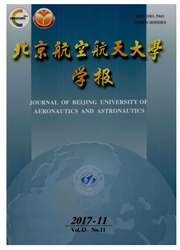

 中文摘要:
中文摘要:
针对现有波段选择方法无法依据感兴趣地物划分数据子空间及子空间划分容易受背景地物影响等问题,提出一种基于光谱特征的自适应子空间波段选择方法.利用感兴趣地物的光谱曲线,建立光谱自适应因子(SAF,Spectral Adaptive Factor);通过聚类划分子空间,在每个子空间内,利用J-M距离筛选类别可分性最大波段作为子空间最优波段,从而得到整个数据空间的最佳波段组合.利用AOTF(Acousto-Optic Tunable Filter)成像光谱仪数据与波段指数(BI,Band Index)和基于类间可分性最佳波段选择两种方法比较,SAF方法选择的最佳波段组合,包含信息量丰富,地物之间差异较大,且地物平均J-M距离大于另外两种方法.用最大似然法(maximum likelihood)对最佳波段组合进行分类,总体分类精度为96.8%,Kappa系数为0.894.结果验证了SAF方法的有效性和实用性.
 英文摘要:
英文摘要:
Adaptive subspace band selection method based on spectrum characteristics was proposed to solve the problems, including the existing methods which couldn' t divide subspace by studied features and background features easily affected the result of subspace division. Spectral adaptive factor (SAF) was estab- lished with the spectral curves of studied features, and the whole data space was divided into some subspace based on clustering. In each subspace, Jeffreys-Matusita distance was calculated to choose the maximum class separability band as the optimal band. The optimal bands combination was achieved. With the data of acousto- optic tunable filter (AOTF) imaging spectrometer, an experiment was accomplished to compare with other band selection methods, involving band index (BI) method and the optimal bands selection method based on the classes distinguish ability. Experimental results show that the optimal bands combination of the proposed meth- od contains better performance and studied features are shown more significant difference. And the average of Jeffreys-Matusitadistance of all classes of the proposed method is the greatest of all methods. Maximum likeli- hood classification method was also implemented on the images of the optimal bands combination of the pro- posed method. As a result, the overall accuracy is 96.8% and Kappa coefficient is 0.89. The experiment in- dicates that the proposed method is effectiveness and practicability.
 同期刊论文项目
同期刊论文项目
 同项目期刊论文
同项目期刊论文
 Development of a dual-path system for band-to-band registration of an acousto-optic tunable filter-b
Development of a dual-path system for band-to-band registration of an acousto-optic tunable filter-b Combined laser and broadband light for measuring the tuning relation of an acousto-optic tunable fil
Combined laser and broadband light for measuring the tuning relation of an acousto-optic tunable fil Simulation of hyperspectral radiance images with quantification of adjacency effects over rugged sce
Simulation of hyperspectral radiance images with quantification of adjacency effects over rugged sce 期刊信息
期刊信息
